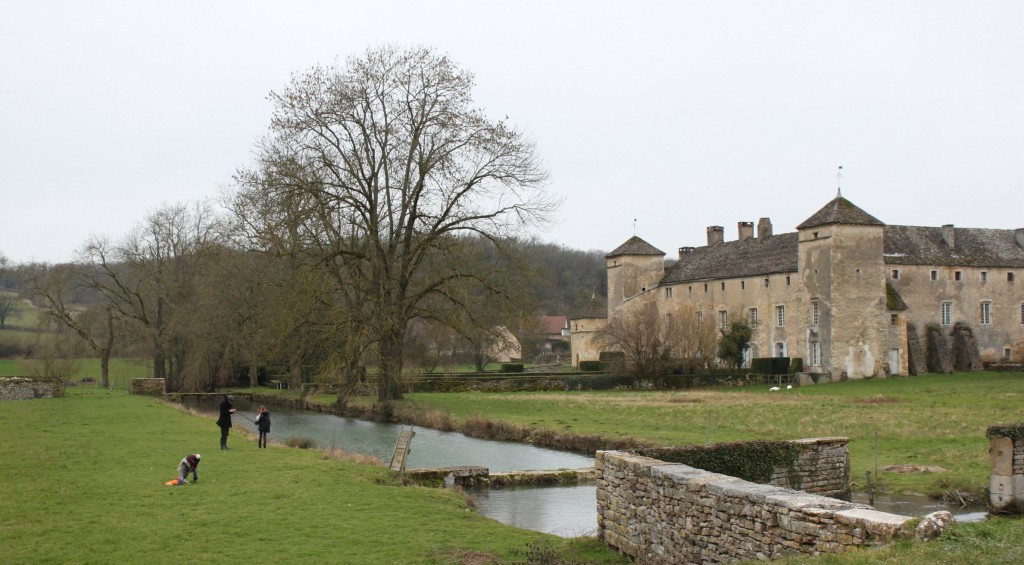 Sure, it sounds like some sort of wacky drinking game played by students at East Coast colleges in the 1950s, but in this case, “Burgundy Blitz” translates rather simply to the Family Heaton’s surgical touristic assault on a beautiful little corner of France – the Bourgogne. Quinn’s baseball club – the formidable Grenoble Grizzlys – had a tournament in the area on Saturday, so we decided to make a weekend of it and see some sights in the area on Sunday.
Sure, it sounds like some sort of wacky drinking game played by students at East Coast colleges in the 1950s, but in this case, “Burgundy Blitz” translates rather simply to the Family Heaton’s surgical touristic assault on a beautiful little corner of France – the Bourgogne. Quinn’s baseball club – the formidable Grenoble Grizzlys – had a tournament in the area on Saturday, so we decided to make a weekend of it and see some sights in the area on Sunday.
Wait…baseball in france?
Yup, sure enough. When we first arrived in Grenoble some six months ago, we were more than a little surprised to find a full-on baseball club competing year-round against other  teams around the Rhone-Alpes region. Right now, we’re in the middle of the indoors season, which is a dang good thing what with it being freezing outside and often covered in snow. Also, this gives me some time to address the involuntary shudder I still have every time I see their uniforms spelled out “Grizzlys” instead of, well, you know. So far, Kristanne has forcibly restrained me every time I’ve attempted to broach this subject with the Grizzly brain trust, but one come a day, she’s not going to be there, and that’s the day I’m probably going to get beat up by French people who don’t care about spelling the same way I do, man.
teams around the Rhone-Alpes region. Right now, we’re in the middle of the indoors season, which is a dang good thing what with it being freezing outside and often covered in snow. Also, this gives me some time to address the involuntary shudder I still have every time I see their uniforms spelled out “Grizzlys” instead of, well, you know. So far, Kristanne has forcibly restrained me every time I’ve attempted to broach this subject with the Grizzly brain trust, but one come a day, she’s not going to be there, and that’s the day I’m probably going to get beat up by French people who don’t care about spelling the same way I do, man.
Indoors baseball might raise a few eyebrows among the purists in the house, but you can go ahead lower those bad boys (and maybe pluck them a bit, too, bushy boy), because it’s still recognizably baseball. Sure, there’s no right field, per se (it’s the gym wall), and they start every count at one ball, one strike, but after that you can pretty much just buy yourself some peanuts and cracker jack and get in a beer-fed brawl with the opposing fans of your choice, because you are at the ole ball game, my friend. Except you have to substitute quiche for peanuts, pain au chocolate for cracker jack, and French “beer” for regular beer – other than that, the ole ball game, you betchya.
Quinn’s baseball tournaments last roughly the length of a Wagnerian opera. In fact, I’ve been trying to convince Quinn to sing bits of Der Ring Des Nibelungen between pitches as an intimidation tactic, complete with much gnashing of teeth and beating of breast, but so far he’s not going for it. I’ll keep working on him, but frankly, he’s not very open to this sort of constructive criticism. Smart kid.
Even Wagnerian operas eventually end, however, and so did the legendary 12U Baseball Tournoi de Cruzilles. Your Grizzlys went 2-1 and lost in the championship to Dijon, good for second place in the tournament and a whole lot of bad jokes about not quite being able to cut the mustard from various – ok, one – crackpot who shall remain nameless, mainly because I’ve already found out the hard way that no one really likes my mustard jokes. Poup on them, I say.
NOTE: I stole the “poup on them” joke from a Facebook friend who shall remain nameless, though, frankly I might have eventually come up with it myself, given enough time and typing monkeys. Let’s move on.
After the tournoi, why not tournus?
With the baseball tournament ended, we headed up the freeway to Tournus, a charming little town on the Saone river, famous for its food, wine, and awesome Romanesque church (St. Philibert, who may or may not be the patron saint of stamp fanciers). We had a delicious dinner at a quiet little brasserie, complete with some escargot (which I ate without even making the obligatory “Look at that ‘S’ car go!” joke), duck, and the famous Bresse chicken, a chicken so famous that she’s subject to the same Appellation d’origine contrôlée laws that govern wine vintages. You can’t call a Bresse chicken a Bresse chicken unless she was raised in Bourg-en-Bresse. Yep – if a Bresse chicken crosses the road, she’s no longer a Bresse chicken (and neither are her eggs, regardless of whether they came first). I believe that these are exactly the sorts of ontological questions that fuel the rich philosophical tradition of France – you can bet your bottom oeuf that Rousseau, Voltaire, and Montesquieu have all tangled with the famous Poulet Paradoxique at one point or another.
The church at Tournus was gorgeous and had an inviting warmth that isn’t always there 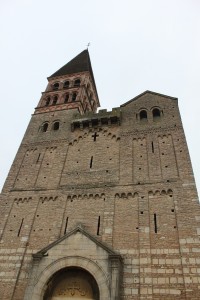 with your average Romanesque church. Yes, I’m married to an art historian and can casually toss around words like “nave”, “transept”, and “pass the Nutella”, though I’m not going to do that right now.
with your average Romanesque church. Yes, I’m married to an art historian and can casually toss around words like “nave”, “transept”, and “pass the Nutella”, though I’m not going to do that right now.
With an itinerary in one hand and an agenda in the other, we knocked out St. Philbert (not literally – it’s not nice to hit saints and, besides, he’s dead) and the rest of the UNESCO site that is Tournus in an hour or so, recharged our batteries both figuratively and literally at a handy cafe’ (the camera was nearly dead), and hit the Burgundy Backroads for our next destination, Cluny.
time to get chateaux-faced!
The drive to Cluny was sort of impossibly scenic, snaking over small hills through vineyards and farmlands, past impressive chateaus and charming villages. Hard not to drive at 10 miles an hour and stop every 30 seconds to take a picture, so we didn’t resist the urge and simply dawdled, enjoying the vistas.
“brancion,” not “branson”
En route to Cluny, we passed the small, medieval village of Brancion. Occupying a strategic hillside (optimistically referred to as a “mountain” by the signage, but, c’mon, you’re only ~100 miles from the Alps – it’s a hill), Brancion was well-preserved and scenic, much like its namesake, Richard Branson. With France being one of the world’s most visited countries and Burgundy being a top destination, we fully expected it to look like this:
I’m not sure where the folks in period costume go during the off season – perhaps to take jobs as Civil War reenactors, or some such – but they are not in evidence in January. Nope, in January, the only other car in the parking lot leaves as you pull up and you’re left to tour the deserted medieval village by your lonesome. Interestingly enough, Kristanne actually owns a book called, “Deserted Medieval Villages,” which is a nice complement to some of her other light fare, such as “Masters of Death,” and “500 German Verbs.” I’m just giving you the eensiest little taste of what life is like as an Art Historian here – you have to work your way up to the hardcore stuff. You know, like, cooing and petting kittens in deserted medieval villages, like she’s doing in the photo below. Hard hitting, I know.
I kept expecting that band of merry rovers from the first picture to leap out from some hidden medieval cranny and amaze us with some sort of leaping hijinks, but it was not to be. We strolled hither and yon, taking in the sights. Now, through the miracle of the Internet, you can, too. Forthwith, some sights:
picnic at your own risk
One thing I will warn you of straight-up is don’t go to Brancion expecting to have yourself some sort of picnic or something. No. That sort of stuff is strictly banned as you can see in the accompanying picture (“Pique-Nique Interdit,” natch).
I’m not sure what the hell happened back on May 10th, 1974, but whatever it was was enough to put the kibosh on any further picnicking in the greater Brancion area. If you even try it, that damn medieval band suddenly appears and forces you to watch them do some Riverdancing while some jackass in tights juggles something.
Hmm. Apparently I have some issues I need to work out when it comes to reenactors.
the french revolution: Possibly a digest version
Did you know that France once had a revolution? It’s true. Revolutions are notoriously difficult to control, which is why I have a strict policy against them in our family. More than once, Kinsey has gone on her whole “taxation without representation” jag and I’ve had to remind her about this policy. Same with Quinn and his ceaseless sloganeering of “Liberté, égalité, fraternité” – without a rule like mine, there’d be anarchy in our house and some very confused household pets.
Unfortunately for the French, they had no such policy, so they had themselves a big ole revolution, with the government, church, and feudal system swept away in convulsive fits of violence and popular uprisings. Tons of churches were destroyed during the Revolution, including the giant one at Cluny. In its time, it was the biggest church in Europe…bigger than St. Peters, bigger than Notre Dame. Now, though, it’s mostly a shell, with only a few bits of it still standing. This gave rise to one of the coolest uses of technology I’ve seen at a museum – giant swiveling iPads. Check out Quinn and Kinsey in action, below – that giant screen can be pivoted and spun so that it faces anywhere on the site. Wherever you point it, the screen updates to show you what was there back in the day. These were deployed at several points around the site…very cool!
Cluny’s museum was extremely well-done and the site itself was impressive, even in its “revolutionized” state.
Time was running short, though, so as the rain began to fall, we bolted for the car and headed back to Grenoble, a merry band of medieval pranksters no doubt trailing in our wake somewhere in the misty distance. Hopefully they get busted for an illegal pique-nique before they find us. See you next time on the Odyssey!

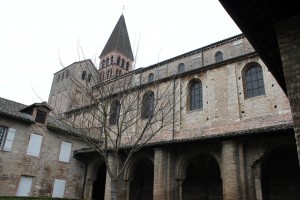


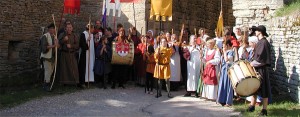

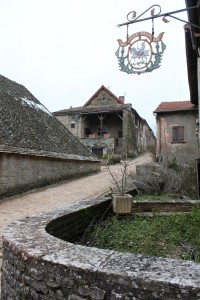
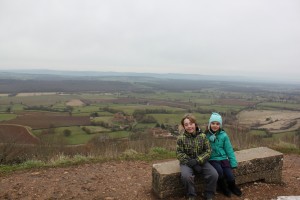
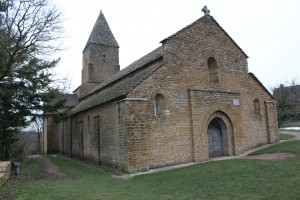
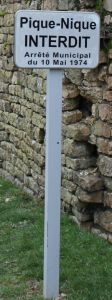
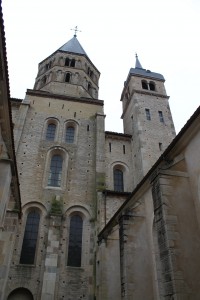
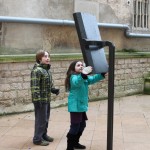
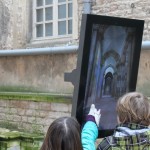
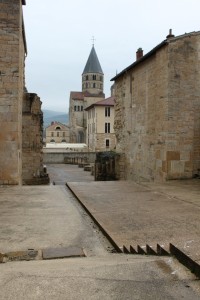
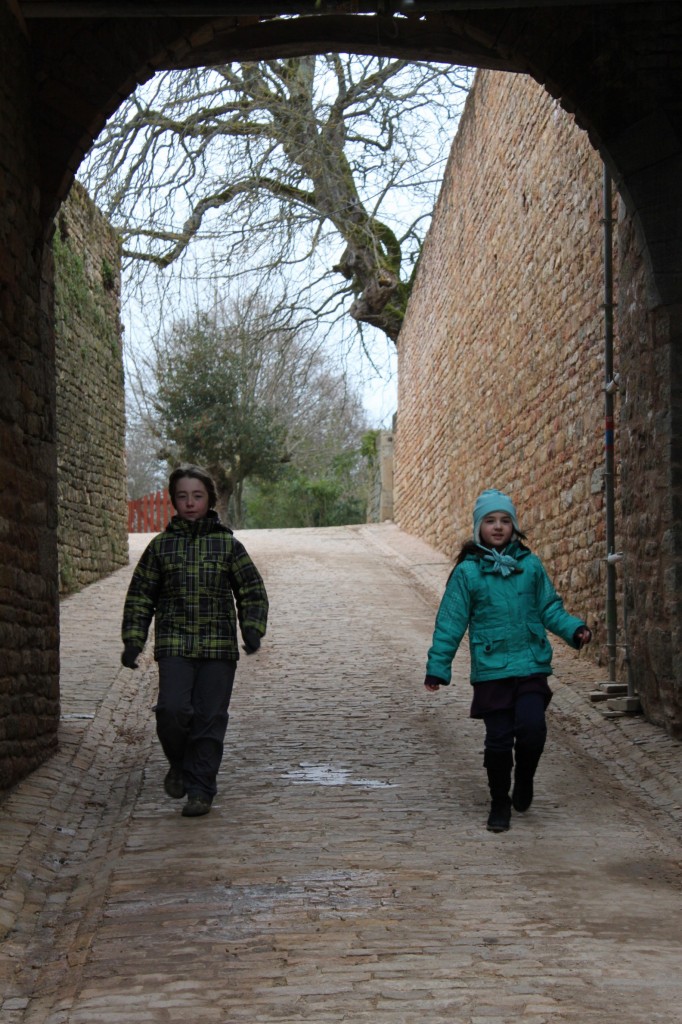
Honestly everyone that reads this must be green with envy. The pictures are wonderful and the travelogue brilliant. The advantage to living there is that you have all the top tourist places to yourself!
Children, buildings, ski areas, medieval sites, photography all wonderful. However I hope that the commentary does not provoke an international dispute. However the poupon references was right up my alley. Thats the alley of appreciation.